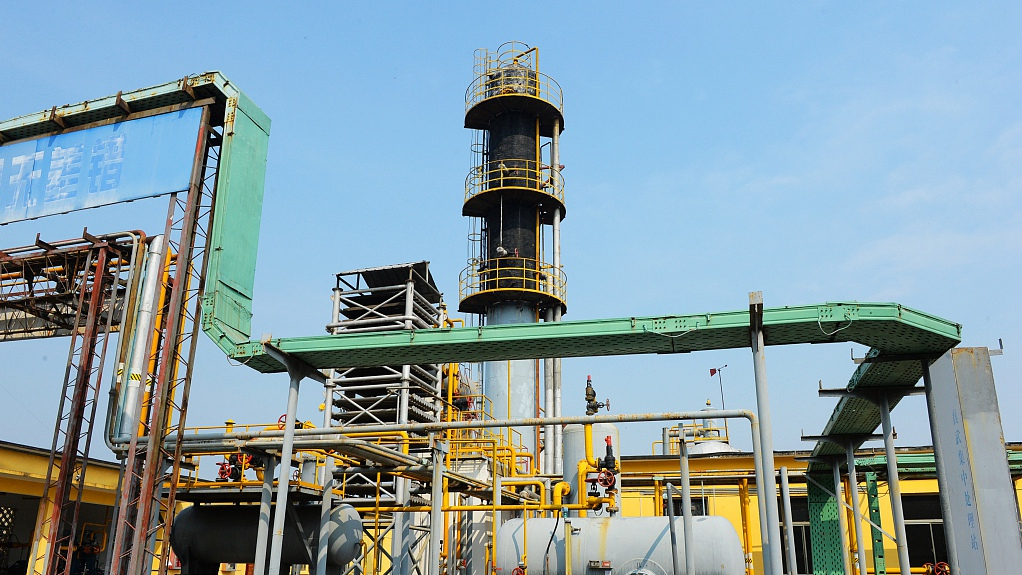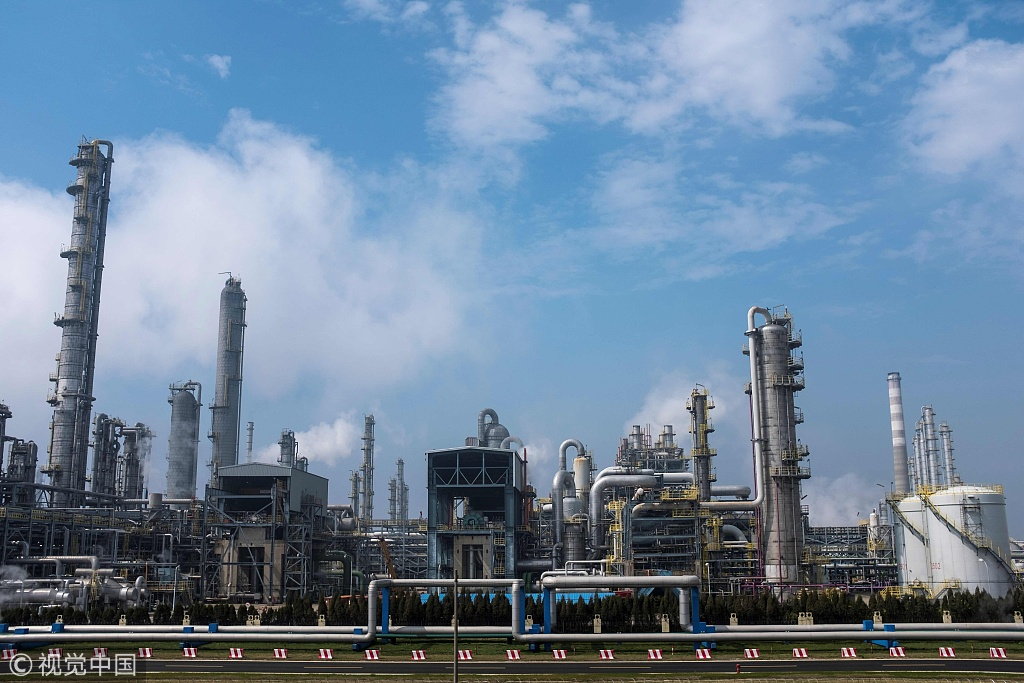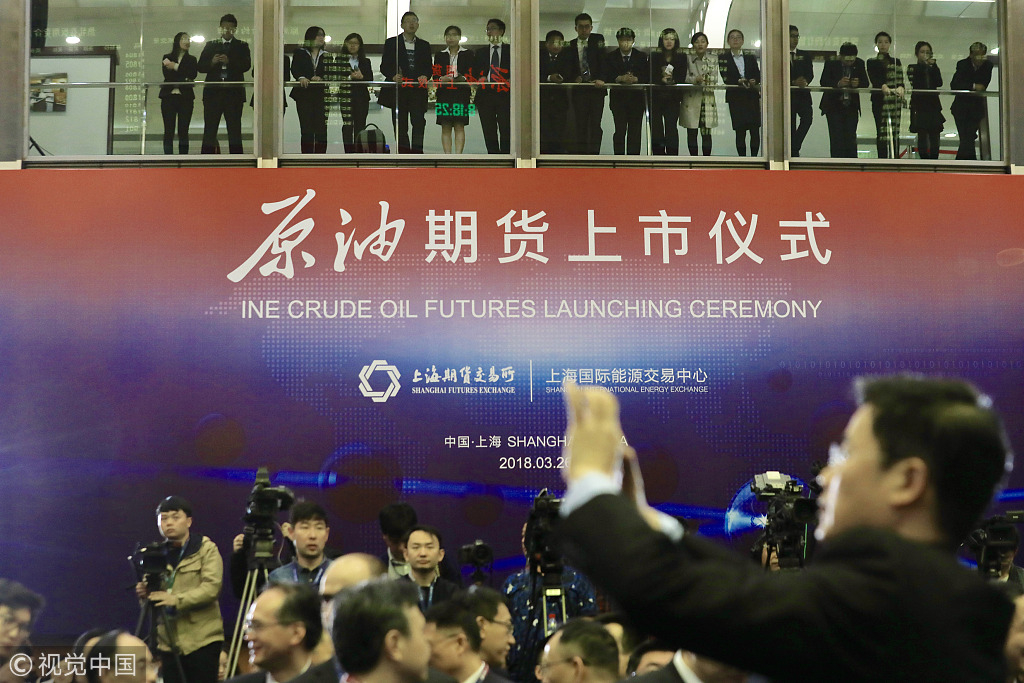
Opinion
14:53, 26-Mar-2019
Crude oil futures have become China's bonded oil pricing benchmark
Fei Kong

Editor's note: Fei Kong is the General Manager of Zhejiang Taixin Resources Co., Ltd. The article reflects the author's views and not necessarily those of CGTN.
China's crude oil futures began trading in Shanghai International Energy Exchange (INE) on March 26, 2018. It has been running for a whole year now. The overall crude oil futures market has been running smoothly, the number of accounts and trade volumes have been increasing and the expectations have been met in terms of trading, delivery, settlement, monitoring, risk control, public opinion and functions.
The main contract price is in line with the trend of international oil prices. It has become the benchmark of bonded oil pricing in China, and reflects the supply and demand in the Asia-Pacific region.
In terms of oil prices, the opening price on March 26, 2018, was 440 yuan per barrel on that day and 454 yuan per barrel at the end of last weekend, an increase of 3.2 percent. Although the oil price has not changed much in over a year, the market has experienced many complex events, especially the remarks made by President Trump on oil prices last year and the yuan appreciation.
In terms of trading volume, the daily average trading volume of crude oil futures has stabilized to about 200,000 lots, second only to (West Texas Intermediate) WTI and Brent. INE crude oil futures trading volume increased from 6.2 percent in April to 37.7 percent in December, and exceeded Brent in July, August, September, November and December 2018. WTI is still the largest trading contract in the world. The daily trading volume is over 1.2 million lots while Brent is between 700,000 lots and 800,000 lots.
China's crude oil futures are not quite a mature market yet. The closing position of INE in the three major crude oil futures increased from 0.2 percent in March to 4.4 percent in August with an average of 36,000 lots per day.
After the introduction of market maker in October last year, INE held 10.6 percent of the three major exchanges in December, with an average of nearly 70,000 lots per day, and the hedging function gradually improved.

A general view shows the Secco Petrochemical complex in Shanghai on March 26, 2018. /VCG Phto
A general view shows the Secco Petrochemical complex in Shanghai on March 26, 2018. /VCG Phto
In terms of liquidity, China's crude oil futures market has reached the level that a futures market could play its role, which also reflects the demand of the corresponding spot market. WTI corresponds to North America and crude oil destined for North America. Brent corresponds to oil prices in most parts of the world, especially in Europe, which are based on Brent's specific prices. Oman crude oil futures correspond to Oman crude oil itself and China crude oil futures to the pricing of bonded oil along China's coast. At present, many enterprises' bonded oil prices have adopted the price of Chinese crude oil futures to execute the contract.
China's bonded crude oil market is at a relatively early stage. In the future, the spot market of bonded crude oil along China's coast will play an important role in the Asian benchmark price market.
The corresponding spot market price is China's crude oil futures. At the same time, on July 16, 2018, the Shanghai Futures Exchange listed bonded 380 marine fuel oil futures, enriching the energy and chemical futures industry chain. Bonded fuel oil is highly correlated with crude oil industry and price, which further strengthens the influence of China's crude oil futures in the Asia-Pacific bonded oil market.

China's crude oil futures begin trading in Shanghai International Energy Exchange (INE) on March 26, 2018. /VCG Photo
China's crude oil futures begin trading in Shanghai International Energy Exchange (INE) on March 26, 2018. /VCG Photo
With regards to the investor structure, the number of crude oil futures accounts in INE has exceeded 40,000. However, the number of overseas investors is relatively limited, and less than 100 of them are foreign investors. However, there are many different types of foreign investors, including natural persons, general legal persons, trading companies and Majors.
Their trading volume accounts for about 10 percent to 15 percent of the total trading volume. Foreign investors still pay a lot of attention to and actively participate in this market. The structure of foreign investors is more reasonable. In the future, with the expansion of market influence and the increase of positions, foreign investors will participate in the domestic market more actively.
As the first RMB-priced international commodity futures, INE crude oil futures are regarded as an important tool to speed up the opening-up of the Chinese futures market, enhance the power in the energy market and support the RMB internationalization. Since the launch of crude oil futures, the CSRC has guided and organized exchanges to internationalize existing and future varieties.
At present, there are two specific futures which have been listed and opened to the international market, namely iron ore which opened on May 4 last year and PTA which opened on November 30.
Because of the differences in market structure, laws and regulations, trading rules (fluctuations, margins) and so on, it is impossible to form a large-scale international market overnight. Only by supporting relevant policies can foreign investors be gradually attracted and the process of internationalization of China's futures varieties be continuously promoted.
(If you want to contribute and have specific expertise, please contact us at opinions@cgtn.com.)

SITEMAP
Copyright © 2018 CGTN. Beijing ICP prepared NO.16065310-3
Copyright © 2018 CGTN. Beijing ICP prepared NO.16065310-3